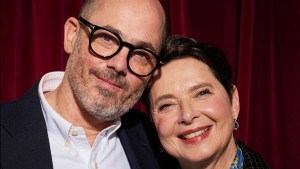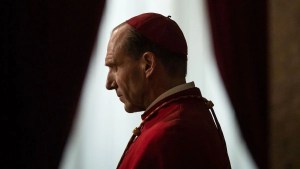Producer Michael Jackman has done it all.
He has 35 years of experience in all aspects of motion pictures. Most recently he’s produced “Conclave,” a papal thriller starring Ralph Fiennes that looks to be a big awards contender this season. But before that, he was EVP of physical production and post at FilmNation Entertainment. While there, he worked on movies like “Arrival,” “Greyhound” and “The Good Nurse.”
He started as a PA and over the years oversaw the construction and operations of a state-of-the-art, 45,000-square-foot post-production facility for Ronald O. Perelman’s Deluxe Entertainment in the heart of New York City; served as senior vice president of post-production at the Weinstein Company and Dimension Films, working on post-production for over 40 films; and supervised several Oscar-nominated films including “Gangs of New York” and “The Aviator,” and was associate producer on Michel Gondry’s “Eternal Sunshine of the Spotless Mind.”
TheWrap spoke to Jackman about how to get eyes in front of a smaller movie like “Conclave,” the elusiveness of a hit movie and why “Conclave” is generating interest while “To Catch a Killer,” a movie he made last year, landed with a thud.
Last night I was watching “Cursed,” a movie that was made at Dimension during your time there.
I have not seen “Cursed.” I have to really push to go to movies. In 2002 I joked that I saw 75 movies, and 72 of them were “Gangs of New York.” Sometimes I miss swaths of important projects that I have to find the time to go back and just watch.
“Gangs of New York” had a famously troubled post-production period. What was the further version away from the version that came out in theaters?
It was probably the first cut, where everything was in. It was probably four hours. It was beautiful to look at and amazing. Some of the stuff actually hard to watch. There’s that opening battle sequence in “Gangs,” which was put to Peter Gabriel’s “Signal to Noise,” and there’s not a lot of sound. It’s mostly music and occasional sounds. But the first cut was a 10-minute sequence and it was so violent, there was no music, and you’re just living in that intensity. It was amazing, but it was exhausting. You were exhausted after the first 10 minutes. Ultimately, I think part of making that palatable was Marty’s decision to just highlight moments and get that driving music that let you into a moment without pushing you too far back.
Harvey Weinstein was, among other things, notorious for meddling with cuts. As a post-production supervisor at Miramax during that period, was it tough to keep him from interfering?
I mean, Marty is no slouch. He’s not one to roll over on things. However, he listens to everything and questions everything. Part of his process is amazing. He’s very strong in how he feels, but he hears. He’s an amazing listener. When I started that film, Marty and Harvey were not speaking and I was the go between. That was fascinating and not the most pleasant. But, you know, it was Marty’s movie. Harvey pushed and pushed and pushed and Marty pushed back. He was not going to be bullied.
What a fascinating front-row seat to have.
I was Oliver Stone’s post-producer on “Any Given Sunday” and the producer, Clayton Townsend, had left the film at that point. So it was me and Oliver, and I was the liaison with Warner Bros., which was also fascinating. They were much better. That was a much better relationship. It’s rarefied air to get at that level, working with these filmmakers that are not just iconic but brilliant in both creativity and memory and how they put thoughts together. It’s an amazing opportunity to learn for me. I mean, you go into something thinking, I know this job, I know how this is going to go. And it’s like nothing at all like what you would have thought. And there’s so many things to learn, and so much I know. I did two films with Scorsese, and I did “Any Given Sunday” with Oliver and it was a phenomenal experience. Hard and you work like crazy, but just loved that experience.
Last year you produced a terrific movie called “To Catch a Killer” that almost nobody saw. As a producer, how do you guarantee that “Conclave” will be seen by more people?
It’s a really good question. All of the experiences that I’ve had, they build upon each other. And I think it’s good to be curious. I love learning new things. If you’re always trying to learn something, you take something away from every project – from understanding the rhythm of how a film preps and shoots and posts, where it’s good to really focus and spend more time at what point? You know how to interpret an audience reaction, a test screening, a friends and family reaction, how to interpret your own first reaction to a cut. These are things that take experience to understand.
I always say that there’s two times I feel scared at a film. One is when you have a screenplay that you feel like, Wow, this could really work, but it’s not quite there. How do we get it there? And two, when you’ve shot the whole movie, and then you’ve looked at some cuts, and you’re like, Oh, this could be great, but it’s not quite there. How do we get it there?
Because you need to start, as a producer, producing. You need to start giving feedback that is actionable and specific, or sometimes overall, but overall that has things that can be pulled by the director so that you’re giving feedback that’s worthwhile. We used to say, when somebody says the movie is slow, it doesn’t mean it’s too long. I’ve had films where we’ve made it longer but it’s felt shorter because it got better, more things that were missing, that weren’t pushing us forward, as opposed to things that just needed to be cut out, to be made shorter. It’s not length. It’s what pulls you through the movie. And I think that those things are just experience. I’ve been doing it for 35 years and I’ve been on every side of the camera. I started as a PA. As a PA, I’ve worked in prep and television and distribution and worldwide delivery and everything in between – producing, post-production, all these experiences just get in your head.
I like to say post-production begins in pre-production. You want to know where you’re going in order to get there. If I’ve got a GPS and I’ve got no destination, I’m just going to sit there staring at my place on the map. I need to know where I’m going. And then you got to think about how you’re going to get there. And then you build that path.
In terms of “To Catch a Killer,” there’s a bit of a Zeitgeist moment. There’s so many different things that go into whether people see a movie, it’s really hard. I don’t think there’s a perfect formula. When does it come out? How is it marketed? How are you marketing to the right audience in the right way? That’s something distributors are great at. I think Focus has been brilliant in their approach with “Conclave,” how they started and how they’ve been. They’ve also put out amazing pieces. The first trailer I thought was terrific. I thought the second trailer was even better. They’ve got dozens and dozens of character pieces that are going out, all over the place. They had a spot in the Mets/Dodgers game, but that’s partially because it’s getting so much heat that they’re starting to put it out there.
Some is the money that is spent on it, but also the approach – what does that first trailer look like? Does it start to catch people’s attention? “To Catch a Killer” was a very hard film. It took a very, very long time to do. Damián Szifron has got an amazing mind but also wasn’t quite used to the process here, and that was complicated. He threw in lots and lots of things at the last minute, which we managed to achieve.
I wish there was an answer to why that one doesn’t get attention and this one does. I think there’s probably 100 different things that all quietly build to either cause that to work or not to work.
Talk to me about “Conclave.” It seems to have been produced very quickly, hit the fall festival scene with a lot of energy and is now carrying that energy into its theatrical run. How do you maintain that excitement?
Tessa Ross, producer, optioned the material in 2016 and she set this project up. She hired Peter Straughan to write it, and had Edward Berger direct it and got it to Ralph, who came aboard quickly. That’s six, seven years ago for her or longer. I’ve been on it for about two and a half years. I came aboard when we were just about greenlit to help do kind of what I do – find that creative balance between Ed and his vision and all of our amazing department heads. Making this movie, it always was going to be a beautiful film with the talent that we had attached and with Ralph Fiennes and our cast, so you had all the great ingredients. And Ed had a really clear vision of what he wanted to do, which wasn’t simple to accomplish, but that was the challenge. How do we get all this done when it was an independent film? How do we achieve all of this and trust in Ed’s vision and creative sensibilities?
He was in the midst of the “All Quiet” juggernaut, which I had seen, and then “Patrick Melrose,” which I had seen. I knew he had a real clear vision. But we had to build the Sistine Chapel. We had to find locations all over Rome that were not the Vatican but felt like the Vatican. The costumes were stunning. We had to support that department buying all this beautiful material from Florence and then making it, as opposed to renting costumes, because you could rent that stuff inexpensively. But it doesn’t look great, and we wanted to elevate everything. We wanted to make it all feel very rich and beautiful. And at the same time, you had these sets that were opulent but a little cold and austere, you know, like strong lines, marble and a very rigid set of rituals. Within that, you have humans who, as they say in the film, serve an ideal but cannot always be ideal.
That’s the warm, emotional part, and the intensity comes from their intense belief – certainty and doubt really conflicting. That conflict with each other can cause a lot of tension. Ultimately, it’s a fun political thriller that is not about making statements, though there are lots of things throughout that do that, but it is really meant to be a fun ride; entertaining but relevant. That was exactly that thing — how do we do it, what we need to do? What can go away? What are the compromises that we can make that will be invisible to everybody else? We want you to engage emotionally. And I think Ralph sets it up beautifully as a homily in the beginning of the movie, where he talks about certainty and doubt. And it’s a beautiful setup for his character, which is a man who is going through a crisis of faith, who is suddenly responsible for the election of the person who is meant to be God’s chosen person to manage your faith. It’s a very interesting place for him to be, and we get to go on that journey with him.
This post was originally published on here









